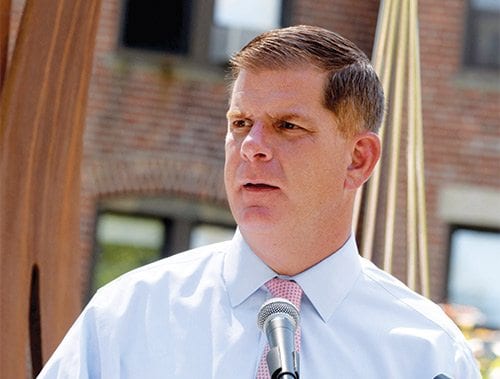
When former City Councilor Chuck Turner pressed for the Boston Residents Jobs Policy in 1981, the plan’s 25 percent goal for hiring black, Latino and Asian workers on construction jobs was ambitious. Although people of color made up 25 percent of the city’s population, building trades unions were widely seen as resistant to diversifying their ranks.
Now more than 30 years later, Mayor Martin Walsh has announced plans to raise the hiring goals to 40 percent people of color, reflecting the increased percentage of blacks, Latinos and Asians living and working in the city.
“The success of Boston’s growing economy relies upon our ability to open the doors of opportunity to all our residents, and remove barriers causing economic inequity throughout our city,” Walsh said in a press statement. “We must work to ensure that the construction industry reflects both the great talent and the great diversity Boston has to offer. By setting new goals for ourselves, we honor our commitment to creating a more prosperous, more inclusive city.”
The change comes as the city is undergoing a major construction boom, with luxury high-rises and multi-unit developments rising downtown and in the city’s neighborhoods. The policy applies to all projects built on city land as well projects totaling 100,000 square feet or more.
“These are clearly good jobs and we’re in the middle of an economic boom,” said John Barros, the city’s Chief of Economic Development. “There’s no better time to make sure all people are benefiting.”
In addition to the increased goal for people of color, the new guidelines up the objectives for hiring of Boston residents from 50 percent to 51 percent, in what Barros calls a symbolic increase.
“It makes a statement that all jobs should have a majority Boston workforce.”
The policy also increases the goal for women workers from 10 percent to 12 percent.
“The women goal is representative of the lack of women in the construction workforce,” Barros said. “The shift by the mayor
is a statement that we have to
do better.”
A new push
The bones of the new policy were developed in November 2014, when Turner and other members of the Boston Jobs Coalition began discussing changes to the then 31-year-old ordinance. In May of 2015, coalition members brought a draft of the new policy to Walsh’s office. After more than a year of review by city attorneys and others, the new goals were finalized.
Turner worked on the original proposal in 1979, which he and other members of the Third World Jobs Clearinghouse presented to then-Mayor Kevin White. White launched the residency policy that year with an executive order. In 1983, the late City Councilor Bruce Bolling filed the policy as an ordinance and it became law.
In the years that have followed, the legislation was honored more in the breach than in compliance. During the two mayoral administrations that the ordinance has been in effect, compliance officers that the city uses to monitor job sites have been in short supply. Often local activists — including the late Herb Jackson — informally monitored construction sites in the Greater Roxbury area to document the frequent violations of the policy.
As the population of people of color in Boston has more than doubled over the last 35 years, its numbers in the building trades have increased.
In large construction projects in the city, people of color average 26 percent of the workforce. In construction projects on city-owned land, people of color average 40 percent of the workforce, according to Turner.
Compliance
In addition to the new hiring goals, the plan includes beefed up compliance measures, Turner says. In the current ordinance, contractors are required to make a good faith effort to meet the goals.
“You won’t find good faith language in the [new] ordinance,” Turner notes. “It says the contractors and subcontractors have to follow set procedures. If they haven’t followed the procedures, even if they can show that they couldn’t find people of color, they’re not in compliance.”
Under the updated guidelines, compliance with the hiring goals will be reviewed at regular intervals during construction. The city currently has six compliance monitors. Turner says they will likely need more.
“We can’t guarantee what’s going to happen, but we think we have a good framework,” he said. “We think this can work as long is the mayor is serious about enforcement and they have to staff to do the monitoring. As in every case, the community has to be vigilant about the projects that are happening in our community.”






